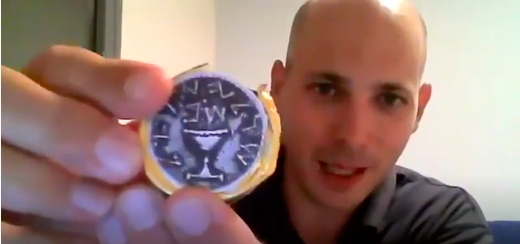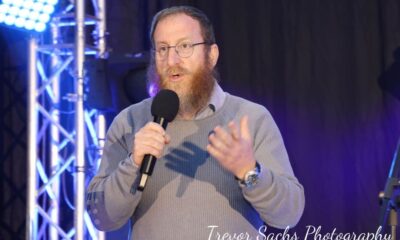
Featured Item

Guarding Jerusalem from the “end of the end” of Israel
The Golan is the true gatekeeper of Jerusalem, particularly in mitigating against the Iranian threat across the border, Israeli Defense Forces (IDF) Major (Res) Yaakov Selevan said during a talk to commemorate Yom Yerushalayim this week.
“People who live in the Golan claim that it’s the most naturally beautiful region in Israel. But they aren’t living here for the views; they are here because there is something for which they’re willing to die – the redemption of the heart of the Jewish people.”
Selevan, a Jerusalem born-and-bred military official who now works as a tour guide and public speaker, was hosted for the webinar by Mizrachi SA and the South African Zionist Federation, in collaboration with other partners.
Although Selevan grew up with “the Western Wall as my backyard”, he now lives with his wife and three daughters in the Golan. Over the years, he has come to realise how deeply intertwined the fates of these two Israeli regions are.
Logistically, the Golan has always been a key strategic point, both in its proximity to neighbouring countries and major water sources, including the Sea of Galilee. Politically, its significance is even greater.
Even in the Roman era, when Roman soldiers were unable to penetrate the Jewish resistance in Jerusalem, they elected to try and attack from the periphery and move down. At the time, the Golan was rich in Jewish life with more than 30 synagogues. In the year 67, in spite of the efforts of Jewish revolutionaries, after a number of attempts, the Romans did overtake the ancient city of Gamla in the Golan. “They killed more than 4 000 Jews. Jewish independence fell, and then the Romans started moving down towards the heart of the land – Jerusalem. Three years later, we know, the second temple was destroyed.”
Fast forward thousands of years, when the Golan was redeemed from Syrian control by the IDF in the 1967 war, a number of fascinating ancient Jewish artefacts were found. The most striking of which was an ancient coin from the era of the Jewish revolt against Roman control. Engraved in Hebrew, its inscription reads “for the redemption of Jerusalem, the holy”.
In the modern political landscape, the Golan remains a contested hotspot particularly in relation to Iran and its ongoing incursions into the borderlands of Lebanon and Syria.
Selevan said that for many years, Iran had also used Israel and Jews symbolically as a strategy to forge allegiances across Muslim and Arab states that otherwise would be divided across Sunni and Shiite ethnic lines. These distinctions are derived from a dispute over the line of succession after Muhammed.
After the Islamic Revolution in 1979, “Iran wanted to ‘export the revolution’, and it realised it had a problem. While they were Shiites, most of the people around them were Sunni.” So, said Selevan, they chose a “common interest – the holy city of Jerusalem. Who controls the old city of Jerusalem? The filthy Zionists.” Moreover, as enemies across the Arab world sought ways to attack Israel, they turned to Hezbollah, which is supported by Iran.
Iran remains a threat to Israel on a number of levels, Selevan said. The first is its nuclear programme; the second its Precision Guided Munitions project, which designs missiles that use GPS to hit specific targets. Third, is its political take over and proxy power in various countries like Lebanon and Yemen. The next key territory which Iran is looking to control in the region is Syria, itself riddled by a civil war that has been appropriated by a myriad of interests.
In Lebanon, Iran controls networks of tunnels and occupied villages where local people are being used as human shields and whose homes are utilised for the storage of missiles and rockets. It hopes to use the chaos in Syria to take over using a similar model.
However, along with military action, Israel has made huge inroads diplomatically to prevent this, Selevan said.
“Iran used us and Jerusalem as a common interest, a common enemy, and a step in the door to the Sunni world. However, in the past few years, with what’s happening just here in Syria, people in the region are seeing what the Iranians are doing and how they’re taking over this region. They realise that they are next in line: Saudi Arabia, even Qatar, Bahrain, the United Arab Emirates, Sudan, all these countries said, ‘Oh my G-d, all these years, we thought the Jews were the problem. Now we understand the greatest threat is the Shiites. Who can help us against the Shiites? The Jews!’”
Israel has thus turned Iran into the common interest which is “our step in the door of the Muslim world”. The most recent result is the Abraham Accords peace agreements, said Selevan.
Israel has another way in which it continues to forge towards peace – humanitarian aid.
Since the Syrian civil war began in 2011, Israel has helped, offering medical services and distributing food, clothing, and other products for basic needs, proving, “you can stop Iran with baby diapers”.
At its core, the motivation for the action is humanitarian, said Selevan. “We did it because we’re Jewish; we cannot stand by when we see people suffering.”
Nevertheless, it also had an impact on political engagement. Terror groups, such as those under Iranian control, are reliant on local populations for support, access to land, and soldiers. As Israel continues to reach out to her neighbours, “there’s a whole generation growing up in Syria knowing that we’re not the devil”.
Although this doesn’t mean there aren’t still many who are against Israel and are manipulating the aid system, nevertheless there are shifts. For Selevan, this is encompassed by a drawing made by a seven-year-old Syrian Muslim girl. Her portrait of the Israel flag, captioned in Arabic, thanks the Israeli who saved her life.
In spite of the huge upswing of attacks on Israel in recent days, Selevan said he was hopeful. His life in the Golan is a contract between him, his country, and his community.
“I’m here at the end of the end of the end of the country because someone needs to be here, because my community is the greatest answer to the Iranian threat. That’s my purpose. That’s my essence.” Holding out a replica of the Jewish-revolt-era coin, Selevan asserted, “Each and every one of us needs to ask ourselves: what’s my job in the redemption of Jerusalem?”










